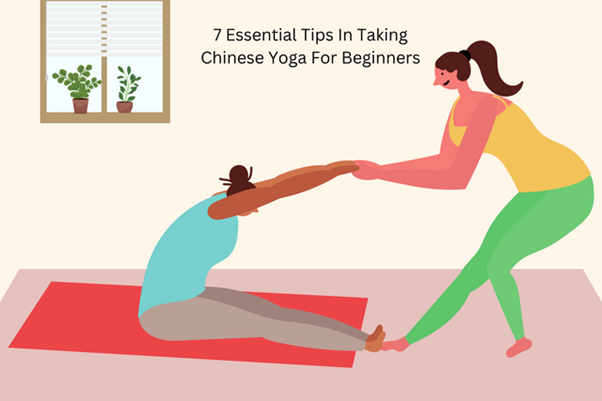Chinese Yoga For Beginners: 7 Essential Tips

Are you planning to enrol in a Chinese yoga class? If your answer is an absolute yes, you will need some tips to help you as a beginner. Enrolling in a Chinese yoga class has excellent advantages for your health. Aside from upholding a fit and flexible body, you also gain peace of mind, relaxation, and soothing therapy for your inner self.
Once you begin practising yoga, you’ll realise it’s much more than just keeping fit and working out. It becomes your way of life, your philosophy, and your passion. It will be a core that keeps you going for something unique. Taking a Chinese yoga class will not only enhance your body fluidity but also calms your nerves and opens the chance for you to communicate with yourself.
You might even inspire others to make changes in their lives or end up being a teacher for someone once you start your Chinese yoga class. To find your distinctive rhythm and move to your beat, you begin to investigate and comprehend all of your layers. Once you have the basic knowledge of yoga, you can opt for a yoga instructor course that will teach more about a Chinese yoga class.
Even if you have a little time each day to devote to yoga, there are various ways you may make it work for you. Observe how your Chinese yoga class evolves gradually over time with the help of a professional Chinese yoga teacher.
When you take a Chinese yoga class, you must prepare yourself for adjustments and other necessary practices. Here are some essential tips that will help you learn Chinese yoga for beginners.
7 Essential Tips In Taking Chinese Yoga For Beginners
1. Find the ideal yoga class and instructor for you.
Attend yoga sessions at the studio if you don’t feel ready to begin your yoga practice. It is preferable to obtain sound counsel early on to know where to start. Based on your actual health and physical makeup, an instructor can advise you on the best poses to do and how frequently.
Keep in mind that yoga instructors adore inquiries. If you don’t understand something, don’t be afraid to ask, especially if your instructor shows you how to perform a pose you’ve never done before. To safely strike the posture, watch it first. Don’t try to listen to your teacher and strike a stance simultaneously. It’s really challenging and maybe hazardous.
An expert Chinese yoga teacher may offer you a lot of knowledge and direction while you practise. In addition to providing you with personalised signals and hands-on modifications to help you attain the correct posture for each position, a skilled yoga instructor can answer your questions during the class.
An excellent teacher should possess the expertise and be approachable, cordial, and sympathetic. Choose your yoga teacher training carefully, as you will spend your time and money learning Chinese yoga. You must be comfortable around your Chinese yoga teacher.
2. Attend the lesson with purpose and without any expectations.
Individuals choose yoga for a variety of reasons. They may do it to deepen their spiritual practice, advance their spiritual development, or maintain their physical health. It’s critical to comprehend your motivations because each one calls for unique methods and expertise.
Make reasonable expectations. Each class should be approached with an open mind so that you may completely engage in the material being covered rather than worrying about your exaggerated expectations. Just accept the fact that you have little control over a lot of things. The practice includes dealing with the unexpected. You’ll have a better chance if you don’t have any expectations before you start.
3. Recognize your limitations and treat your body with kindness.
In Chinese yoga class, you must stop doing anything if it hurts. Likely, you are not performing a posture correctly, or you might have a previous injury or other problem that makes you uncomfortable. It would be best if you didn’t continue in a particular pose. Being a little uncomfortable is not the same thing as experiencing pain.
At first, a deep stretch could seem tricky, but with some deep breathing and relaxation, you can usually get used to it without discomfort. Be kind, and don’t push yourself above your limits, especially when you’re just starting to learn, no matter what feelings you experience. Take your Chinese yoga class as you are still a beginner.
4. Be honest with yourself and have fun.
While a crowded yoga class could seem solemn and severe, it can also be a place to smile, open your heart, and radiate love. Starting your Chinese yoga class gives your body and mind the chance to adjust to the poses we progress through and get accustomed to our alternate breathing patterns. Once your body has gotten used to it, you can gradually enrol in more challenging classes and try new physical flows.
Start slowly and avoid letting your body dive in headfirst since you will appreciate it much more if you do. It is essential to start with relatively basic poses when you first begin your yoga practices. It would be best if you gradually become accustomed to the yogic tradition. Always begin by warming up. By doing this, you’ll get your body ready for upcoming activities and safeguard yourself from harm. Give it some time. Give your body the space and time to adjust to the practice.
Be careful to enjoy all the learning experiences, even if you are practising by yourself at home. It includes when you awkwardly fall out of a position or feel like you are inelegantly copying a rubber band. Successful Chinese yoga class requires you to accept yourself and all of your feelings.
5. Identify the physical flow that suits you.
When you first begin practising yoga, pay close attention to how you feel that day. Choose a flow that seems right to you, and keep returning to that reason. What are your goals for your yoga practice, and why are you here? Listen to what works for you and tune in to yourself.
You can participate in a variety of different physical practice elements. You have more relaxing stretches and slower positions. With each breath you take, you are generating heat and strength within your body.
Knowing this is crucial as you understand that yoga is more than just a class where you move through one or two positions.
6. Don the appropriate attire.
Make sure you are wearing comfortable, loose-fitting clothing. You must dress in a way that will make moving around easy for you. Your motions will be light and more straightforward if you wear a comfy yoga suit and breathable clothing. You don’t need to worry about being uncomfortable. No matter what kind of practice you do, it’s crucial to feel confident in yourself.
You don’t want your clothing to restrict how freely you can move. In addition, after you discover the style of yoga or positions you enjoy, you could find that a yoga block, bolster, or straps allow you to perform poses as efficiently as possible. Ideally, you can test out these tools in a nearby studio during class to learn how they function and how to utilise them most effectively. A good yoga mat and a blanket for ‘savasana’ at the end of the Chinese yoga class are always wise purchases.
7. Steer clear of comparisons and believe in your abilities.
Yoga is a personal path; thus, there is no benefit in comparing and assessing your progress to that of others by looking at theirs. You can be inspired and motivated by their bodies’ powers, but don’t berate yourself if you aren’t there yet.
Suppose you’re interested in doing yoga; you can contact Yoga Mandala for their Chinese yoga class.








